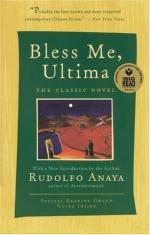|
This section contains 7,925 words (approx. 27 pages at 300 words per page) |

|
SOURCE: “Bless Me, Ultima,” in Rudolfo A. Anaya: A Critical Companion, Greenwood Press, 1999, pp. 25–44.
In the following essay, Olmos provides an overview of the major themes, narrative techniques, and critical interpretations of Bless Me, Ultima.
In Rudolfo Anaya's first novel he turned to his life experiences for inspiration. The story of the awakening of the consciousness of a young boy growing up in a small New Mexico town shortly after World War II closely parallels the author's own life (see chapter 1 herein). At the same time, however, Bless Me, Ultima is a highly original work with a unique story and a universal appeal that established Anaya's international reputation. This chapter will focus on his best-known novel, a work of poetic beauty and richness that introduces the themes and motifs that have become the hallmark of Anaya's writing.
Narrative Strategies
How can a story told from the vantage point...
|
This section contains 7,925 words (approx. 27 pages at 300 words per page) |

|


